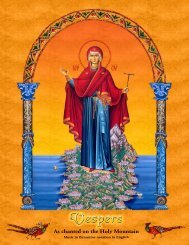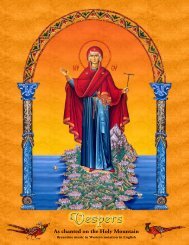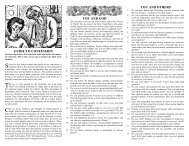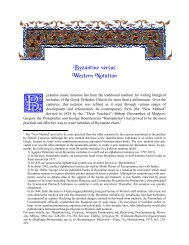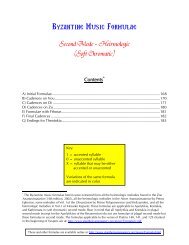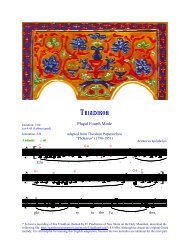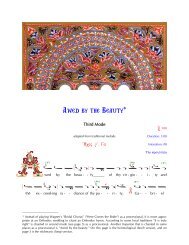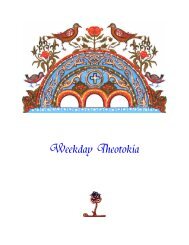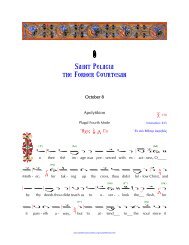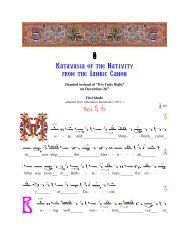Reading Psalmodia (PDF) - St. Anthony's Monastery
Reading Psalmodia (PDF) - St. Anthony's Monastery
Reading Psalmodia (PDF) - St. Anthony's Monastery
You also want an ePaper? Increase the reach of your titles
YUMPU automatically turns print PDFs into web optimized ePapers that Google loves.
melodies for Saturday evening and Sunday Morning. If the short melodies are used,they should be sung at a rather slower pace than the verses that follow.G] DOXASTIKAIn both Hesperinos and Orthros the sequences of stichera end with one or moreDoxastika, and a similar Doxastikon-Theotokion completes the verses of theAposticha. Doxastika are normally sung to Slow melodies of some complexity. Shortsettings also exist, and, though they are rarely used, they are very beautiful.Whichever version is used, the Doxastikon should be sung expansively, at a slowerpace than the verses which precede it.H] CHERUBIKON & KOINONIKONThe music of the Divine Liturgy varies in pace. At two points, the preparation for theGreat Entrance and the Communion of the Clergy, slow, extremely elaborate chantsare normally used, in the Tone of the day. Both of these chants reflect the identity ofthis Liturgy, here in this temple, with the angelic worship of the Court of Heaven.The chant of both Cherubikon and Koinonikon should be slow, serene, recollected. Inboth cases, however, shorter melodies also exist which require a different, plainerstyle of execution.I] GREAT DOXOLOGYThe Great Doxology is a very ancient Christian hymn. It is sung antiphonally. Agreat variety of both Short and Slow melodies are in use. This hymn stands at theend of Orthros, as the culminating act of glorification of God. The great Doxologyshould be sung in an exultant (diastaltikon) style and at a pace suitable to acelebratory chant.J] TRISAGIONThe Trisagion hymn stands before the Scriptural readings which form the focal pointof the Liturgy of the Word of the Synaxis. The cry "Holy, Holy, Holy" is the cry of theangels about the Throne of God, to which in the Liturgy our voices are joined. Thehymn is normally sung in Tone II, the customary echos of the Synaxis, but can besung in any echos. The Trisagion should be sung in an exultant manner, the Dynamiseven more so. The Dynamis should be a powerfully exultant piece, lifting the heartsand minds of the people, readying them to hear and receive the inspired word of thescriptural readings.K] PSALMSThe chanting of the Psalms has given eccelsiatical chant its name, <strong>Psalmodia</strong>. Thepsalms are chanted in a number of different ways: in direct psalmody the singer orsingers chant the psalm as a single continuous poem, in antiphonal psalmody tosingers or two choirs chant alternate verses of the Psalm, in responsorial psalmodyone singer or choir sings the verses of the psalm, while the rest of the singers respondwith a refrain.The sung psalms of Hesperinos and Orthros, including the psalm Eleison Me O Theosare normally sung antiphonally: the Prokeimena, when sung in their full form, areexamples of responsorial psalmody. The Antiphons of the Liturgy are originallyantiphonal psalms, though a refrain has come to be attached to the Psalm Verses.Normally Psalms are sung to simple, rapid melodies which vary little from verse to



